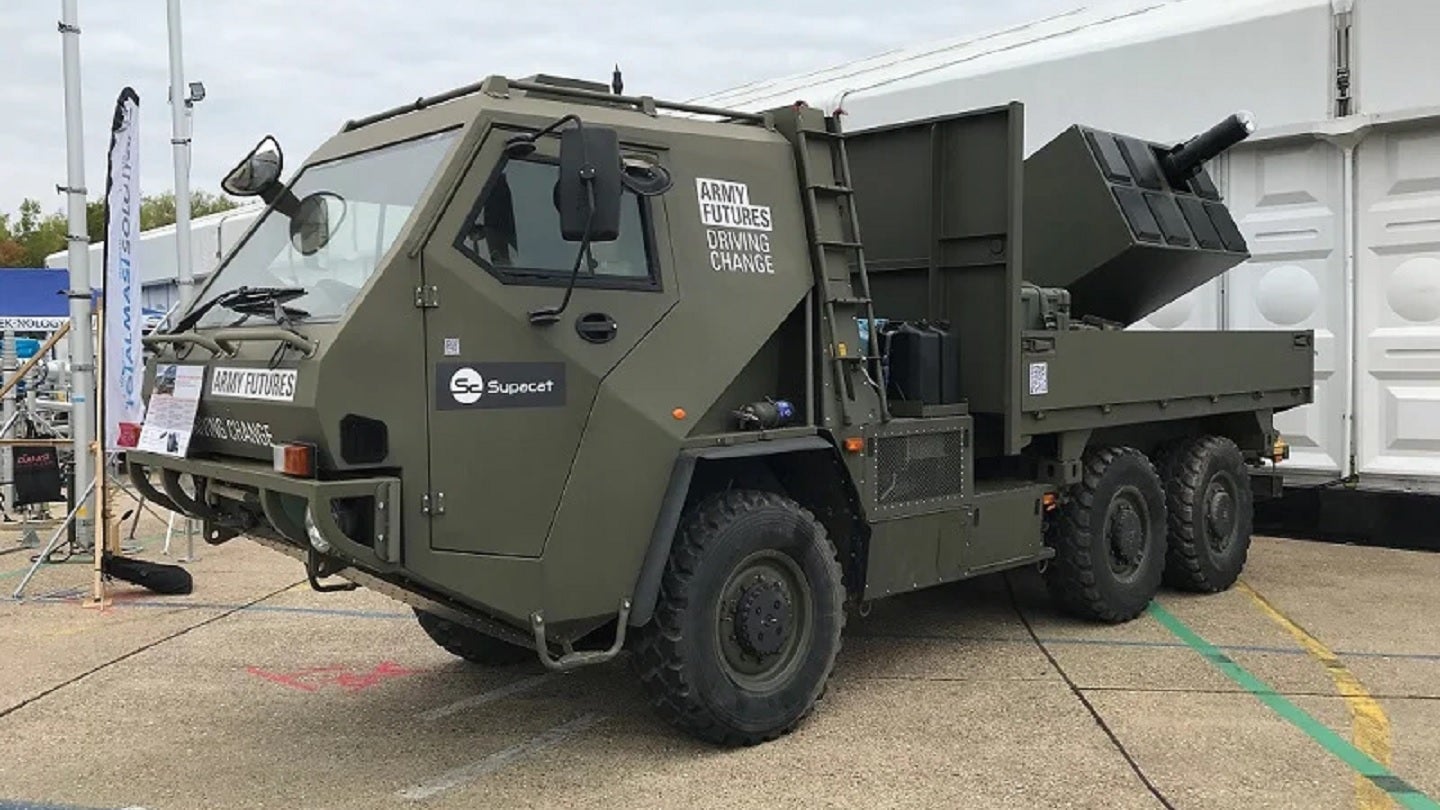
The UK’s Project Wolfram, a little-known programme to develop a next-generation mobile anti-armour capability utilising the Brimstone missile, could be set to begin live fire tests as early as Q2 2024, in the latest step to provide the British Army with a battlefield-shaping weapon.
As currently envisaged, Project Wolfram is testing the viability of fielding the Brimstone missile, already used by the Royal Air Force in a ground attack role, from a land vehicle, offering a potential shoot-and-scoot capability that has become recognised as critical in lessons being learned from the ongoing war in Ukraine.
Currently managed under the British Army’s Battle Group Organic Anti-Armour (BGOAA) programme, a concept demonstration of Wolfram was seen at the DVD 2022 event at Mibrook proving grounds, where an eight-cell ‘Brimstone’ canister was seen fitted to a flatbed truck.
At present, Wolfram, as it is still a concept, is not part of the British Army’s current equipment programme. However, it could inform the development of requirements for a capability to be brought into the service’s Land Operating Concept, at which point it would most likely be integrated into infantry battlegroups to defeat adversary tanks and armoured vehicles.
As reported by Army Technology at the time, the platform is in fact a joint effort by the UK Ministry of Defence (MoD), pan-European missile manufacturer MBDA, and UK-based vehicle provider Supacat.
MBDA’s Brimstone missile has proven a success since its entry into service in 2005 and has been mentioned in the US Congress as a capable weapon system. Supacat itself is a significant provider of light mobility platforms to the UK military, such as with the Jackal and Coyote platforms.
In teaming up a combat-proven missile with a relatively inexpensive delivery platform, coupled with a capable but cost-effective delivery platform, the UK MoD could in fact deliver a mobile fires capability into service far sooner than first thought.
The Brimstone missile system is known to have been provided to Ukraine and was seen in social media images in May last year being fired from a flatbed vehicle by Ukrainian forces towards Russian targets. The same month, then UK Defence Minister James Heappey confirmed that hundreds of Brimstone missiles in UK stocks would be sent to Ukraine.
Thought to have a range of around 25km, the Brimstone missile is capable of striking a range of target types, according to manufacturer MBDA, including fast moving vehicles, tanks and armoured cats, bunkers, as well as for anti-ship warfare in the maritime domain.
Brimstone also features an IM-compliant rocket motor and multi-effect, tandem-shaped charge warhead with an impact, delayed or proximity fuse capability. Weighing around 50kg, 1.8m-long missile is guided by a millimetric wave radar and semi-active laser system.
“Wolfram is a mobile Brimstone rocket launcher concept being demonstrated by industry and is one of many ideas being developed as we learn lessons from Ukraine. Wolfram is not yet fully developed as a capability,” an MoD spokesperson said in a statement.
Modularity driving British Army thinking
The need for open architecture systems and modularity is driving much of the British Army’s thinking, with projects such as the Land Mobility Programme, which will drastically reduce the number of platforms designs in service from 16 down to around five, indicative of a move towards host platforms being possible carriers of a variety of capabilities.
Project Wolfram is understood to also fall into this category, and rather than fixing to a specific host vehicle, instead seeing a Brimstone capability that can be swapped out from platforms such as the Boxer 8×8, to a more basic flatbed, as needed. To that end, Wolfram could less indicate a traditional platform-and-weapon-system approach, but rather set it goal in finding the best way to deliver the effect, in this case, the Brimstone missile.
Indeed, the UK military, and British Army in particular, looks to be reshaping itself significantly following lessons being learned from Ukraine’s war against Russia, where mobility and medium- and long-range fires have proven to be decisive influences on the battlefield.
In the 19-months since Russia full-scale invasion against its neighbour Ukraine, the UK has provided huge quantities of its legacy land capabilities to Kyiv, including L118 105mm light guns, AS90 155mm self-propelled howitzers, as well as more advanced capabilities such as the Challenger 2 tank and M270 MLRS.
One of the most significant steps in recent months was the UK provision of Storm Shadow cruise missiles to Ukraine, which were recently utilised to apparent significant effect in strikes on Russian-held Sevastopol naval base.
In March this year the UK signed an agreement with Sweden for 14 Archer 155mm self-propelled artillery systems, with the battery expected to be operational by the start of Q2 2024, forming an interim replacement for the 32 AS90 artillery systems the UK “gifted” to the Armed Forces of Ukraine.
The wheeled Archer 6×6 is equipped with an automated, self-propelled 155mm main gun designed for rapid deployment, with a firing range of 50km using extended range ammunition – doubling the AS90’s 25km range.
This article has been updated to include a comment from the UK Ministry of Defence.








